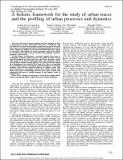A holistic framework for the study of urban traces and the profiling of urban processes and dynamics
Author(s)
Vaccari, Andrea; Liu, Liang; Biderman, Assaf; Ratti, Carlo; Pereira, Francisco; Oliveirinha, Joao; Gerber, Alexandre; ... Show more Show less
DownloadVaccari-2009-A holistic framework for the study of urban traces and the profiling of urban processes and dynamics.pdf (1.296Mb)
PUBLISHER_POLICY
Publisher Policy
Article is made available in accordance with the publisher's policy and may be subject to US copyright law. Please refer to the publisher's site for terms of use.
Terms of use
Metadata
Show full item recordAbstract
Pervasive systems produce massive amounts of data as by-products of their interaction with users. Cell phone calls can inform us on how many people are present in a given area and how many are entering or leaving it. Geotagged photos can tell us where tourists go within the city and how much time they spend in each place. Descriptions of events, products, and services allow us to characterize places based on their most popular activities, products, and services. In this paper we illustrate a research agenda that aims at developing a holistic framework for the study of urban traces and the profiling of urban processes and their dynamics which will enable us to better understand how cities function and to develop more efficient urban policies. We also present the results of a preliminary case study in New York City where we analyzed the correlation between cell phone network handovers and traffic volumes and between semantic indexes of public events and local variations in cell phone activity. The results showed that there exist causal relationships between these types of data, and confirmed that there is strong promise in the holistic study of urban traces.
Date issued
2009-11Department
Massachusetts Institute of Technology. Department of Urban Studies and Planning; Massachusetts Institute of Technology. SENSEable City LaboratoryJournal
12th International IEEE Conference on Intelligent Transportation Systems, 2009. ITSC '09
Publisher
Institute of Electrical and Electronics Engineers
Citation
Vaccari, A. et al. “A holistic framework for the study of urban traces and the profiling of urban processes and dynamics.” Intelligent Transportation Systems, 2009. ITSC '09. 12th International IEEE Conference on. 2009. 1-6. © 2009 IEEE
Version: Final published version
ISBN
978-1-4244-5519-5
Keywords
Holistic Framework, digital footprints, geocodable buzz, urban dynamics, urban processes, urban traces
Collections
Related items
Showing items related by title, author, creator and subject.
-
11.001J / 4.250J Introduction to Urban Design and Development, Fall 2001
Vale, Lawrence (2001-12)Examines the evolving structure of cities and the way that cities, suburbs, and metropolitan areas can be designed and developed. Guest speakers present cases, involving current projects, which illustrate the scope and ... -
11.016J / 4.211J The City, Spring 2003
Spirn, Anne Whiston, 1947- (2003-06)Examines the evolving structure of cities, the dynamic processes that shape them, and the significance of a city's history for its future development. Develops the ability to read urban form as an interplay of natural ... -
4.241J / 11.330J Theory of City Form, Spring 2004
Beinart, Julian (2004-06)Theories about cities and the form that settlements should take will be discussed. Attempts will be made at a distinction between descriptive and normative theory, by examining examples of various theories of city form ...